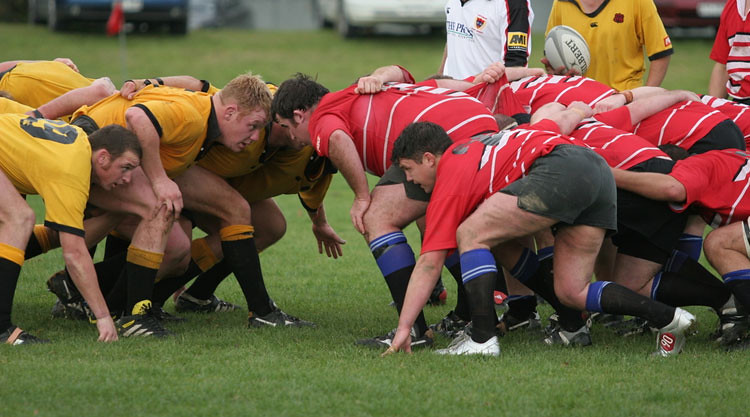Even though not that many rugby injuries occur in scrums - less than 10% - when they do, they can be severe, making up around 40% of serious injuries.
As opposing sides collide together in the scrum while vying for forward momentum, players experience considerable multidirectional forces. These repeated collisions may lead to both acute and longer-term degenerative injuries, such as arthritis.
With around 5-6 million rugby players worldwide, efforts to reduce this force could have a huge positive impact on the long-term health of many of the world's rugby players. But this needed to be achieved with minimal effect on the scrum's competitive nature.
The Rugby Science team at University of Bath conducted a two-phase study funded by the International Rugby Board (IRB) across a wide range of teams, from schoolboy to elite international level, to:
- establish the degree of force that front row players are subjected to in their upper and lower back when the scrum engages
- test alternative methods of engagement.
Pushing back on the force of "the hit"
“Crouch, Bind, Set” emerged as the technique that markedly reduced peak forces during scrum engagement without influencing the levels of sustained force during the pushing phase.
Live and lab trials of the crouch, bind, set engagement sequence demonstrated a 25% reduction in the forces on engagement- known to players as 'the hit' - at all levels of the game, which is a big plus for the long-term welfare of players.
The new sequence in action
Props now pre-bind with their opposition player prior to the engagement of the forward packs - reducing the force of impact, and the issues of collapses and resets that have been so prevalent at the elite level of the game.
The front rows are closer, the binding stronger and the ball doesn't enter the scrum until the set-piece is stable.
The new scrum protocols will hopefully lead to fewer collapses, fewer re-sets and a genuine contest for the ball.
England forwards coach Graham Rowntree expects the new laws to develop "stronger scrummagers who are technically more efficient".
A stabler scrum
The engagement of the scrum has been one of the most troublesome areas of the international game in recent seasons, with a high proportion of put-ins leading to free-kicks, penalties or re-sets.
41% of scrums collapsed during last season’s Six Nations.
While addressing scrum collapse issues is not the driver of change, it is hoped that the new sequence, coupled with strict application of law by referees and universal buy-in, could lead to a more stable platform - with fewer collapses and resets.
Engaging with the changes
The IRB Council approved the trial in May 2013, alongside a suite of five other aspects of law on player welfare enhancement grounds. The research team submitted their analysis to the IRB's Scrum Steering Group who then recommended the new engagement sequence for global implementation.
This was followed by a gathering of the International Rugby Board’s top referees at the Fédération Française de Rugby’s Centre National de Rugby in Marcousiss, near Paris for a workshop in August 2013 to hone their management of the new sequence.
Reaction to the transition to ”Crouch, Bind, Set” by the rugby fraternity has been very positive.
Brian Moore, the former England hooker turned rugby columnist, and an outspoken critic of how referees handle the set-piece, described it as "our last chance to save the scrum."
And John Jeffrey, chairman of the IRB's rugby committee, described the law as a "seminal moment" in the development of the sport.
REF submission
This research was part of our REF 2014 submission for Sport and Exercise Sciences, Leisure and Tourism. Our sport research was ranked 5th in the UK.
